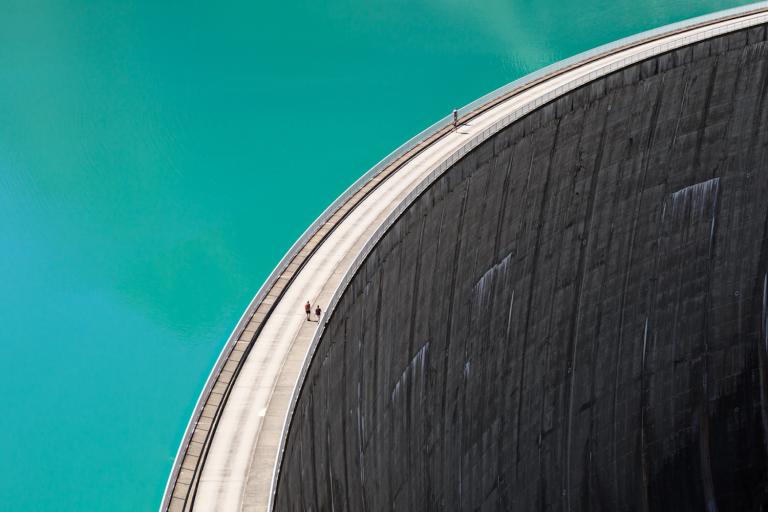Finding a crack in a dam: easy as IoT

Bridges, dams and other infrastructure need continual inspections to prevent and repair damage. IoT sensors can be our eyes and ears in those hard to reach places.
What do bridges, viaducts, dams and roads have in common?
They are all large public structures that need constant monitoring for cracks, deformations and shifts that could affect their capacity to function, or cause accidents.
But carrying out those observations is difficult. The equipment needed for the job is bulky and expensive, and often available only for short periods of time.
According to Business Insider there are 612,000 bridges in the US alone and nearly 56,000 of them need some kind of repair. In 2019 in the EU, the European Transport Forum reported that too much of Europe's ageing infrastructure is “crumbling" and in need of an overhaul. This resulted in MEPs voting yes to a €43.85 billion budget to support the Connecting Europe Facility (CEF) project, aimed at developing and maintaining infrastructure between national borders.
“Mobility is the basis for jobs and growth. We need modern and efficient infrastructure in Europe," said the French MEP Marian-Jean Marinescu, who drafted the Parliament's CEF legislation.

Tiny IoT-connected sensors can gather detailed data about the tension, vibration and geometrical configuration of concrete structures; making maintenance easier and more efficient.
More than just an upgrade
In 1967, the Ponte Morandi viaduct opened in Italy, connecting Genoa to the French Riveria. On Tuesday, 14 August, 2018 a section of it collapsed during a torrential rainstorm. Approximately 35 vehicles fell from the bridge and 43 people died.
This was Italy's eleventh bridge collapse since 2013, but all across the EU there are roads, railways, bridges, ports and other mobility structures under strain and in need of maintenance.
The Minister for Transport in Germany's North Rhine-Westphalia, for example, feels strongly about the deterioration of an autobahn bridge connecting Cologne and Leverkusen. “This is a monument to the desolate condition of German infrastructure," he told smart-industry.net.
When the bridge was completed in 1965 it was a proud achievement, built to support 40,000 automobiles each day. 51 years later, the average number of vehicles had increased to 120,000 including up to 14,000 heavy trucks. Adding to the literal pressure this bridge faces was an increase in the weight of new cars and trucks.
Restricting weight on one bridge only shifts the problem to others. The issue in Germany, and worldwide, can't be solved by temporary traffic solutions or maintenance alone.
This is where IoT can really save the day.

IoT sensors allow for regular inspections at higher frequencies and lower costs, assisting in the detection of failing structures sooner.
A crack— no longer a needle in a haystack
In addition to natural depreciation from wind, humidity, heat and seismic events, unexpected damage is often caused by vandalism and accidents. This is usually reported late, not at all or goes unnoticed.
Prior to IoT technology, the impact of these events could only be identified through regular visual inspections carried out by engineers. In Germany, these inspections occur only once every three years and therefore, cannot provide the information needed to ensure functionality and safety.
The data that the IoT sensors collect can facilitate new and improved public policy, that in turn helps to keep infrastructure safer and in service. For example, sensors can record the effects of speed and load limit restrictions. This provides operators with the information needed to make more informed recommendations on maintenance intervals and work.
It should be noted, that IoT detection sensors are not meant to replace visual inspections but can provide significant support through sensor data.

Sensors have the potential to rescue monitoring costs between 10 and 100 times, depending on the type of structure and number of devices used, reports ZDnet.
The first “intelligent bridge" was opened to the public near Nuremberg in Bavaria in October 2017. This “smart bridge" has three types of sensors, fitted inside the bridge's expansion joints, which collect a constant stream of data: structural integrity, traffic patterns, vehicle speed and weight, the number of axles and the distance between them.
As more governments hustle to repair their infrastructure without breaking the bank, “Smart Bridge" technology is gaining traction. Business Wire estimates that the “Worldwide Smart Roads and Bridges Market is expected to reach USD$2.66m by 2022."
Read more about how IoT can help you make your city safer.
Have your say
Sign up for our newsletter
Why sign up:
- Latest offers and discounts
- Tailored content delivered weekly
- Exclusive events
- One click to unsubscribe